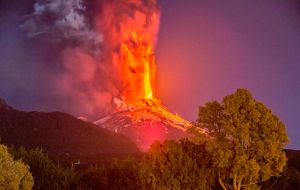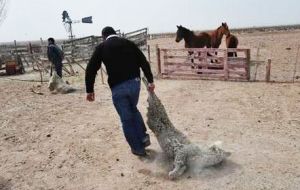MercoPress. South Atlantic News Agency
Argentina lost 12% of national flock to severe drought in north Patagonia
 The lack of humidity is recurrent with the most impact between 2007 and 2011, plus very cold temperatures and the eruptions of Chaiten and Puyehue volcanoes.
The lack of humidity is recurrent with the most impact between 2007 and 2011, plus very cold temperatures and the eruptions of Chaiten and Puyehue volcanoes.  In the eight years starting in 2007, an estimated 1.8 million sheep were lost in Chubut and Rio Negro, which is equivalent to 12% of the country's 14.5m flock
In the eight years starting in 2007, an estimated 1.8 million sheep were lost in Chubut and Rio Negro, which is equivalent to 12% of the country's 14.5m flock North Patagonia in Argentina is suffering the worst drought is 17 years which has meant the loss of 1.8 million sheep, since 2007, and so far this year rainfall has been 45% below the historic average.
“It is possible that the situation worsens in coming months since the flocks won't have enough grass to feed during this coming summer and the 2017 fall and winter” indicates a report from the University of Buenos Aires Agronomy School. The report was based on a survey of sheep farms in the provinces of Chubut and Rio Negro.
The lack of humidity is recurrent in these Patagonian provinces with the most impact between 2007 and 2011, when two of the worst droughts in six decades were recorded together with bottom rock temperatures and the eruptions of the Chaiten and Puyehue volcanoes.
According to estimates from Argentina's Agro-industry ministry in the eight years starting in 2007, an estimated 1.8 million sheep were lost in Chubut and Rio Negro, which is equivalent to 12% of the country's total flock of 14.5 million. The two provinces make up 43% of Argentina's total sheep.
“This climatic situation is of an exceptional magnitude” points out the Agronomy School and INTA (Agriculture Technology Institute) report indicating that lack of grass growth is evident in the region anticipating a complicated scenario for the rest of the year and the first half of 2017.
With a poor spring forage resources for the next winter will be insufficient, and thus the report intends to warn farmers to prepare for a significant contraction in feeding resources during the next twelve months.
“Emergency measures are needed since it it statistically most improbable that sufficient rainfall will occur before April 2017 Further more it is possible that not even the historic average will be reached”.
Given that the sheep load will have to be lowered considerably, the report recommends a drastic reduction of flocks by selling old ewes, reject rams and all discards as soon as possible following lambing and shearing. The objective must be to conserve the young ewes to ensure wool and lambs in 2017, and if possible advance weaning this season to help mothers build a strong structure, concludes the report.




Top Comments
Disclaimer & comment rules-

-

-

Read all commentsThey're probably just not getting enough radiation from Kepi Troll's soporific WWIII scenario.
Sep 28th, 2016 - 02:12 pm 0What was he saying about that famous Mendoza orographic rain-shadow that protects Fortress Argentina and shields the country from all that nasty precipitation that might otherwise have been carried on the Westerlies from Chile?
1
Sep 28th, 2016 - 03:21 pm 0ML
That must be Southern Hemisphere, friendly' radiation from China, North Korea or other spiritual Herman's of the brave Patagonians.
And it was so recently that I_Trolltally_Invent_Everything_I_Post said “You are the ultimate imbecile, volcanoes are the best long-term fertilizers of land on Earth.”
Sep 28th, 2016 - 05:44 pm 0Who is the ultimate imbecile now? :-D
Commenting for this story is now closed.
If you have a Facebook account, become a fan and comment on our Facebook Page!